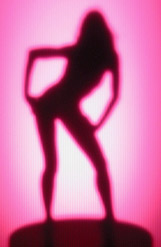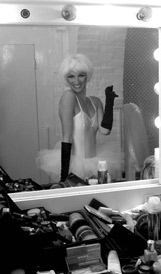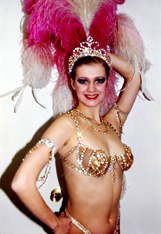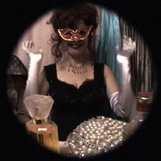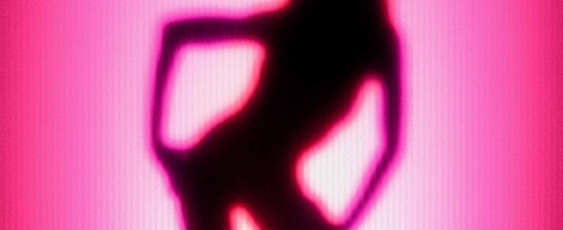
Going to Extremes
Transgression and transformation, pastiche and pasties - all this and more as Dorothy Max Prior loses herself in the world of Burlesque performance.
It's a mellow autumn day, and we are at the lunchtime launch of the International Workshop Festival 2003 on the HMS President, a sturdy oak-panelled vessel moored near Blackfriars. There is cheese and wine, olives on cocktail sticks, a ballroom with a low stage and a reception lounge with a long mirrored bar. Perched on the velour armchairs are a selection of people who are dressed in clothes that signify 'sex' to almost anyone you'd care to ask: gentlemen in gigolo suits and slicked back hair; ladies in tight satin dresses, stiletto heels, feathers and furs.
For this is not only the launch of the IWF, but also the inaugural event of its sister organisation, the London Academy of Burlesque, launched under the guiding hand of Miss Lara Clifton who with Miss Tamara Tyrer also runs Whoopee, 'London's first 21st century Burlesque club'.
Looking for all the world like a dodgy MC at a wedding, festival director Luke Dixon introduces our entertainment. First, we have Delilah, a rather chaste striptease dancer complete with twirling pasties - an unreconstructed old-fashioned striptease. The second act is Miss Bella Donna (aka Natasha Bolonkin), in contrast a grotesque postmodern pastiche - a mock-striptease complete with moth-eaten fur coat from under which is removed bra, panties, falsies and ultimately a rubber prosthetic vagina. Welcome to the world of New Burlesque...
The gloriously-cleavaged Jo King, patronne of the London School of Striptease, is standing on the ship deck, taking in the September sunshine. I join her, and over a good few glasses of wine we discover that we are both veterans of the pubs-at-lunchtime, clubs-in-the-evening heyday of British striptease, which kicked off in the early-to-mid 70s as Go-Go dancing in white kinky boots and moved into something far more burlesque with Salome 'harem' costumes (as worn by the late great Jacqui Martine), shiny She-and-Me PVC and leopardskin ¼ cut bras (the best were made by two lovely ladies in a little room off Bethnal Green Rd, I seem to remember).
In those long-gone glory days, the striptease artiste working the East End pubs (particularly if it was a Sunday morning slot in Ilford or Dagenham) would quite likely find herself performing on the same bill as a comedian and a wrestling tag-team. Here we have a range of performance mores that satisfy Jo King's burlesque definition: a variety of different acts that are 'comedic, saucy, glamorous, outrageous.' We are reminded by Roland Barthes (in Mythologies) that striptease and wrestling are both based on contradiction: wrestling looks like a sport but is a spectacle; stripping seems to be about nudity, but is actually about covering, exoticizing, occluding the naked truth: the straight forward purity of the unadorned human body. Everyone who has worked as a professional stripper (of the burlesque school) knows that you NEVER end naked. There must be shoes and/or stockings and/or gloves - or at the very least jewellery or hair bows.
Jo King is someone who has subsequently ventured into the alternative-art world of cabaret clubs like Whoopee - and she also runs very popular striptease workshops (entitled Six Ways to Remove a Glove) for the IWF. But like many others involved in Whoopee, her roots are in the 'real world' of regular punters - although she has resisted the wretched 'get-em-off and forget the tease' style of recent years: 'I cut my stripping teeth on Burlesque-style striptease. My work is generally based on different personas: glamorous diva, wild rock-chick... I've created more than thirty characters over the years. I have always enjoyed performing in a very tongue-in-cheek manner. I think my intrinsic theatrical vibe is completely informed by and related to the essence of burlesque.'
This 'essence of burlesque' as Jo puts it is something that is seen by many artists as having three different strands of historical influence: classic American burlesque in the early 20th Century, the Naughty Nineties and beyond in Paris, and the saucy Victoriana of old postcards and early film in Britain.
First, a brief trip to the USA. In her intro to Strip Show - Performances of Gender and Desire (Routledge: London, 2002), Katherine Liepe-Levinson points out that 'in its first heyday in the 1920s and 1930s the strip show as burlesque was so popular it threatened to engulf all the legitimate theatres on Broadway.' Striptease was declared an 'all-American art' in Congress - and its most famous ambassador, Gypsy Rose Lee, was awarded an honorary doctorate by a posse of New York University professors.
The now-familiar combination of luscious costume, transgressive sexual innuendo, camp, comedy and music (first jazz, then rock) defined burlesque, the tradition continuing right through the 20th Century to the present day, with the success of the Miss Exotic World museum and annual gathering, curated by the legendary Dixie Evans (heroine of performance artist Lois Weaver), proof that burlesque in the USA is still very much alive and kicking. Journalist Andrew Gumbell, writing in a feature in the Independent on Sunday, pointed out that 'where old-style burlesque was a pre-cursor to girlie mags, the new USA troupes (such as Lucha Va Voom) are like a resistance movement against porn'. These sentiments are echoed by Deborah Berke, director of Lost Vagueness, who feels that 'not everyone finds constant explicit imagery and instant gratification to be truly entertaining. In this age we are numbed to the explicit and thus seek out that which is more teasing...'
Chris Meikan of Continental Drifts looks to Gay Paree as a major burlesque influence and sees the release of the film Moulin Rouge as a defining moment, when something that was bubbling underground went global. He is the promoter of Lost Vagueness, a burlesque total environment presented at Glastonbury Festival and elsewhere, with its own in-house ten-strong Can Can team, Can-Booty-Can, choreographed by circus star KT Sarabia. Chris's definition of burlesque is one shared by a number of commentators: 'it's frills, spills and interaction with an audience. Clubs like Whoopee are popular not just for the performance but because the public join in by having dress codes and taking on their own role.'
This carnivalesque blurring of roles is something of interest to Deborah Berke, who puts it this way: 'it's all mixed up and turned around and one asks - who is performer, who is guest, who is serious and who is a stooge? Lost Vagueness is not just about presenting burlesque artists on stage; it creates an entire world of burlesque parody and twisted norms. At Glastonbury, Lost Vagueness is the size of a small village, with The Chapel of Love and Loathe (where guests can get involved in a whole cabaret of rituals, from marriage to divorce, bingo to boxing); The gourmet Silver Service Restaurant - an oasis in the midst of muddy fields of hippies; The Ballroom, featuring Come Dancing and Ska/punk/gypsy bands. Also, the casino, roller-disco, laundrette, trailer-park and sculpture garden.'
The notion of a total environment in which performers and audience become merged in the shared fantasy is, for many commentators, at the heart of burlesque: what Richard Schechner called 'the performer as extension of the environment' into the creation of clubs or bars where the 'performing spectator' enters the space. Echoing this thought, Chris points to the success of clubs such as the S&M playground Torture Garden, which he says is 'way ahead' in their understanding of the 'extreme burlesque' performance environment.
For performance artist, dancer and filmmaker Katie Etheridge, the influences have come from 'softer' sources - Victorian ephemera and old film. Her first brush with burlesque was as a dancer with the long established Brighton-based VaVaVAVOOM (under the direction of fan-dancer and chanteuse Ms Stella Starr): 'Outside the faux fur and velvet cocoon of the club, I soon realised that in most peoples' minds burlesque equals stripping, full stop.' But for Katie, it was always far more: 'I have always been fascinated by old postcards and photographs, and a large part of what drew me into burlesque was the archival images. Seductive, intense, rich, and quirky, sometimes impossibly glamorous, sometimes just weird...'
Researching early dance on film, she came across many 'one-minute wonders' from the early 1900s starring female dancers, which inspired an installation in the window of the Old Clock Shop, Brighton where tiny little screens, surrounded by luscious red velvet curtains, showed her creative interventions on these early burlesque and music hall classics. Mistress of the East: La Charmeuse de Serpents, for example, 'takes the early 20th century craze for eastern exotica, and fondly mocks the fakery and deadpan delivery of artists such as Ruth St Dennis and many other anonymous women who danced for the camera in an exotique guise'.
Another artist who has taken burlesque as her starting point but moved it into new territory is Marisa Carnesky. For over a decade she has Oom Pah Pah'ed at alternative clubs and cabarets, whilst simultaneously working the real world strip clubs and bars - following in the footsteps of many other female performance artists including Karen Finley, Annie Sprinkle and Cosey Fanny Tutti who've straddled both worlds (so to speak). She co-created the Grotesque Burlesque of latex-masked Dragon Ladies for the Raymond Revue bar, but has no regrets about moving on at just at the moment when a style of work she has pioneered becomes flavour-of-the-month.
Carnesky shares with Russian theatre maestro Meyerhold an interest in the fairground sideshow as a theatrical model, and in her latest major work Ghost Train (2004-2005) she has created a full-scale fairground ride animated by traditional theatrical tricks and magical illusions, and peopled with a changing rota of female performance artists. Using her family's history as Jewish refugees from Lithuania as a starting point in an exploration of concepts of 'otherness', she has created a visually stunning piece that tells the stories of many different women in exile. Silently screaming faces fade in and out of focus; bodies swing by on ropes; a flock of doves dissolve into the ether; exotically dressed figures that are sometimes ghostly blurs, at other times fully physically embodied move in and out of a succession of doors, traps, cages and mirrors, an endless succession of women on-the-move using what they've got, making do and biding their time...
After a successful run at London's Brick Lane in 2004, Ghost Train toured throughout 2005 to numerous sites, including the Glastonbury Festival. In the meantime, Carnesky is still treading the boards - as the penny-in-the-slot tattooed-lady fortune-teller (as seen at the Whoopee Club), and as part of the Duckie team with the Total Theatre Award winning C'est Vauxhall (re-titled as C'est Barbican when it wowed the crowds at Barbican BITE).
According to Duckie, who have performed at all sorts of venues, from their 'home' at Vauxhall Tavern to the London International Festival of Theatre, 'performance art is the new table dancing' - although it looks as if it is also true to say that table dancing is the new performance art...
Whichever way we look at it, the comic, saucy, imaginative and tongue-in-cheek melange that is burlesque, far from being a period-piece from the 20th century is very much here to stay as a powerful aspect of performance practice in the 21st century.
Reflections:
- Cos I'm a Woman,
W-O-M-A-N
Miriam King
Dramaturgy in Action
Beccy Smith
Big Daddy versus
Mother Hen
Marigold Hughes
Through the Threshold
Carran Waterfield
A Woman's Place
Alex Hoare
The Mother
Dorothy Max Prior
Dances on Street Corners
Virginia Farman
Wollstonecraft Live!
Anna Birch
The Right Kit
Alex Mermikides
Going to Extremes
Dorothy Max Prior
